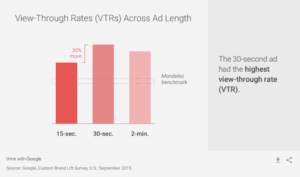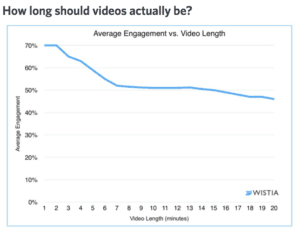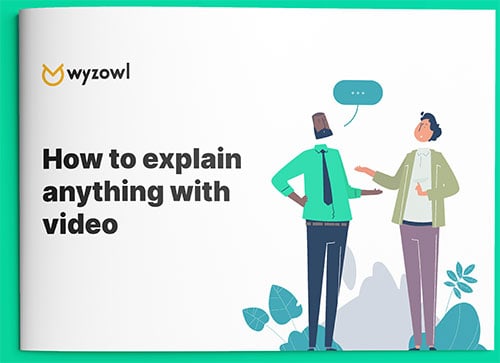An explainer video is a big investment, especially for start-ups and small businesses. The best way to get a return on that investment is for viewers to watch your video all the way through and act upon the call to action (CTA) at the end of the video.
So that raises the question:
How long should my explainer video be?
You need your video to be long enough to include all of the important information about your brand, product, or service; but you also need it to be short enough that viewers don’t get bored and click away before seeing your CTA.
In this article, we’re going to take an in-depth look into explainer video length, including different theories and research, to help you come to a conclusion that’s best for you.
Theory #1: The first 5 seconds are all that counts
This theory works upon the grounds that if a viewer clicks on a video and it hooks him/her within the first couple of seconds then they will stick around to watch the rest.
Now, five seconds isn’t a lot of time to work with. But if you know what you’re doing, it’s just enough time to plant a little seed of curiosity in your viewers’ minds. One of the best ways to hook viewers is to ask a question that they are desperate to know the answer to.
Another great way to hook your viewers is to set up a situation that is familiar to them, like this:
Within the first 5 seconds of each of these videos, the scenarios are perfectly set up, again speaking to the ideal customers of these brands.
It doesn’t matter how you hook your viewers, whether you do it by asking a question, by creating a relatable situation, or a different way, as long as you speak directly to them.
Another reason it is important to hook your viewers in the first 5 seconds is because when a person clicks the play button on your explainer video, it could be their first impression of your brand. If they don’t like what they see, they’re going to leave and they might never come back. So make sure that you set the tone clearly in that very first frame.
Theory #2: Shorter is better
It’s no secret that human attention spans are shrinking. More than 40% of online adults are multi-device users and millions of content floods onto those screens every day. So if your content isn’t snappy and to the point, you could lose your viewers to a video that is.
Your explainer video is to your product or service what a teaser trailer is to a Hollywood blockbuster. You don’t want to give too much away in your video because this doesn’t generate any buzz or excitement among consumers. Plus, if your video is really short – like, 6 seconds! – then you have the option to place it as an unskippable ad on YouTube, meaning guaranteed views for your money.
Theory #3: Length doesn’t matter
Interesting idea, don’t you think?
A study by Think with Google questions the theory above, and a notion that a lot of marketers seem to believe: shorter is better. For the purposes of the study, three YouTube ads were created for the same product. The ads ranged from 15 seconds to 2 minutes in length, and the results didn’t show what you might expect. Take a look at this graph:

As you can see, the shortest video had the lowest view-through rate, meaning less people watched the 15 second video all the way through than the 2 minute one.
The theory for this is that with longer videos, viewers have more time to become invested in the story and build a more meaningful connection to the brand. So if you have a strong and entertaining story to tell, then longer just could be stronger.
Read the full study here.
It depends on the type of video
You may have already realised that when it comes to video length, there is no one size fits all. If you have an opt-in audience then you can capture their attention for much longer than you would have if they just began watching your video by chance. Here, we’re going to take a look at different types of videos and how their purpose also determines their length.
Chance viewings
1. Pre-roll
Pre-roll videos are the short ads that appear before YouTube videos. They range from 6 seconds all the way up to a couple of minutes long. Pre-roll videos are tricky because, on the one hand, they’re the easiest way to get your video in front of thousands of people, but on the other hand, these people are as far from an opt-in audience as you can get. They aren’t on your website, they aren’t researching your product, they just want to watch YouTube content. Therefore, pre-roll videos need to be as short as possible. As mentioned above, the 6 second videos are completely unskippable, so if you can condense your message into a short amount of time, I would suggest you do so. Think about Theory #1, in 5 seconds you can peak a viewer’s curiosity and sometimes that is all it takes to lead someone to your website to find out more about you.
2. Product demo
Product demos are usually found on various landing pages on a brand’s website. Sometimes they can even be featured on the homepage. Videos that are on your website can be longer than pre-rolls, because there’s a reason that the viewers are there -they’re interested and they want to know more. However, people who choose to click and watch your product demo are still chance viewers, they aren’t obligated to stay and watch until the end, and the won’t unless they’re motivated to do so. With product demo videos, you should pick a couple (maybe 3 or 4) of your USPs and present these along with the benefits of your product for the viewer. No more, no less.
You can learn more about product demos on our product demo video agency page.
3. Company culture
Company culture videos are similar to product demos in that, the people watching must have a slight interest in your brand, or they wouldn’t have found and clicked on your video. So this means that you have a little more time than a pre-roll video, but not as much time as an opt-in video. I’d suggest no more than a few minutes for a company culture video. As with the product demo, select a couple of key points to highlight and present these in an engaging way that demonstrates the culture of your company. The best way to achieve success here is to show the video to as many people as you can before finalising it and putting it live. Get their opinion on whether they would watch the full video, and if not, where they feel their attention begins to drop off.
Opt-in viewings
1. Training video
When you’re training staff, it’s important to keep them engaged. However, because they are ready and willing to watch your video, there doesn’t really need to be any restrictions on time. It is much more important that you display all of your information clearly than it is to cut the length down.
2. Webinar
Webinars are, on average, the longest form of video mentioned in this article so far. They’re aimed at opt-in viewers who usually have to sign up prior to the event to gain access to the footage. Having said that, it is still very important to respect the time of your viewers. In my experience, most webinars usually run from around 45-60 minutes, with around half an hour of talking from the speaker and the rest of the time divided by an introduction at the beginning and questions from the viewers at the end.
3. Tutorial
People are watching tutorial videos for a specific reason: they want to learn. When you have viewers who are opted-in to watch a tutorial video, length isn’t a priority. It still matters, because you don’t want viewers to feel like they’ve wasted their time and leave unsatisfied. But you can feel more comfortable taking your time and ensuring you explain things properly.
What does the research say?
No marketer wants to make a decision without looking at the cold, hard facts. So let’s take a look at some…
Wistia
A 2016 study by Wistia found interesting correlations between video length and engagement. They drew their data from 564,710 videos with more than 1.3 billion plays collectively, and came to the conclusion that the ideal length for an explainer video is 2 minutes.

As you can see from the graph above, engagement was found to be steady up to the 2 minute mark, meaning a 90 second video can hold the attention of viewers just as well as a 30 second video can.
After the 2 minute mark, engagement drops rapidly. However it does seem to even out between 6-7 minutes, and stays strong until 12 minutes; meaning if your content is interesting and includes necessary information for the viewer, then you could make a longer video without suffering a loss in engagement.
Takeaway:
Don’t sweat the small stuff. Wistia’s study has proven that, as long as you keep your video under 2 minutes, you can deviate by a few seconds and engagement won’t suffer.
PEW Research and ReelSEO
In 2012, PEW Research conducted a study to determine the most popular length for YouTube videos. Half of all these videos were less than two minutes long, however, the most popular length was determined to be 2 minutes and 1 second.
In the same year, ReelSEO studied the top ten most shared videos on YouTube and found the average length to be 4 minutes and 11 seconds.
Takeaway:
YouTube videos can be longer. People go to YouTube to specifically watch videos, so it makes sense that they would be open to watching and sharing videos that are “on the longer side”. However, it is important to consider that these studies were conducted over 5 years ago and consumer behaviours are changing all the time.
Wyzowl
At Wyzowl, we surveyed consumers in early 2017 about video length and other video marketing related topics. The responses regarding length were as follows:
- 50% of consumers believe that 1 minute is the ideal length for an explainer video
- 33% opted for between 1 – 2 minutes
- 17% said less than a minute
Takeaway:
Shorter really IS better! According to the respondents we asked, no explainer video should be over 2 minutes in length, with a majority preferring videos to be 60 seconds or less.
TL;DR
Watch this:
Final thoughts
I know I’ve given you a lot to think about here, but video length is a crucial factor when it comes to engagement, so it is important that you don’t take the decision lightly! First, consider what type of video you’re going to make, then refer to the information above to decide how long that video should be.






